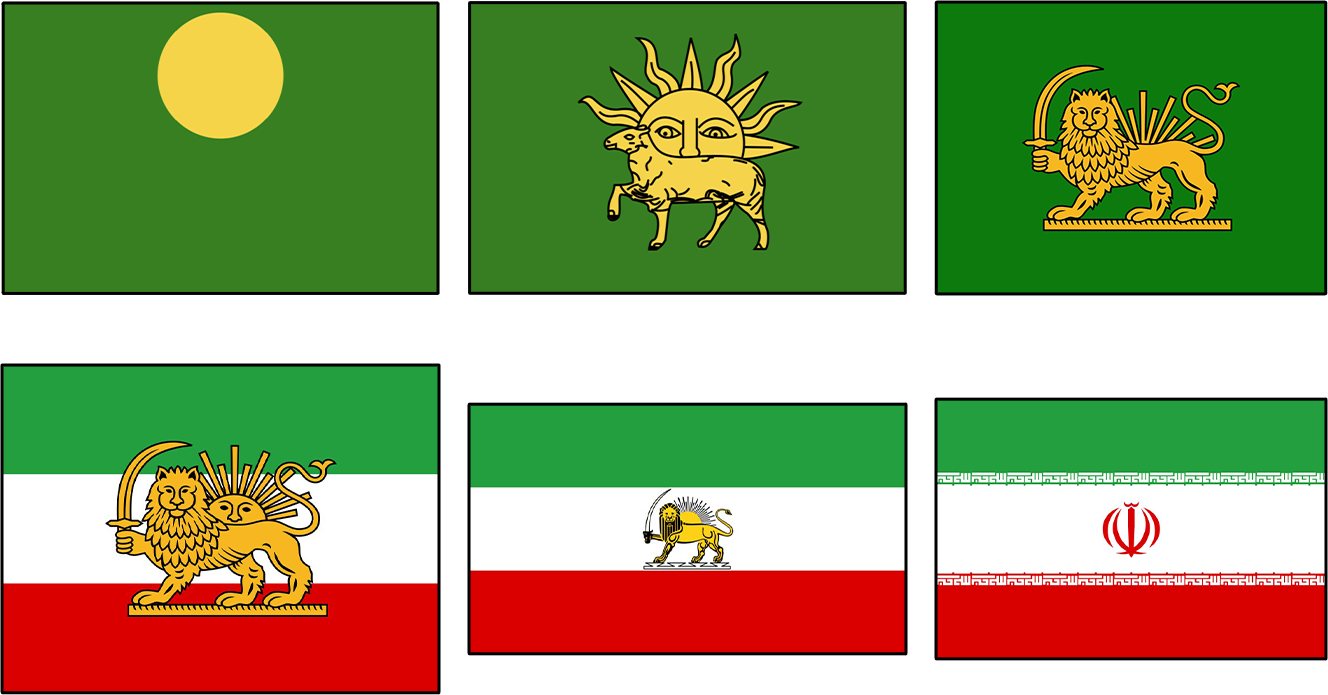The flag of the Islamic Republic of Iran has three colors (green, white, red), with the sacred word "Allah" written in the middle, and the slogan "Allahu Akbar" written in Kufic script around the central white stripe.
The flag of the Islamic Republic of Iran has three colors (green, white, red), with the sacred word "Allah" written in the middle, and the slogan "Allahu Akbar" written in Kufic script around the central white stripe.
According to Article 18 of the Constitution, the flag consists of three identical stripes of green, white and red with the special symbol of the Islamic Republic and the motto Allahu Akbar. The symbol in the center is represented by the Tauhid emblem, which means the phrase "lā ʾilāha ʾillā l-Lāh" (There is no God but Allah). This phrase is written in red in the form of the word "Allah". The artistic analysis of this sign is a red tulip rising from the blood of revolutionary martyrs, the four parts of which look like a crescent moon, and the middle vertical part resembles a sword, which is a sign of strength and resilience.
The slogan "Allahu Akbar" is written eleven times against a green stripe and eleven times against a red stripe, i.e. a total of twenty-two times in Kufic calligraphy (the same font used to write "Allahu Akbar" on the minarets of mosques).
All the phrases "Allahu Akbar" are written in white and have no outline. The upper 11 inscriptions are depicted on a green background, and the lower 11 on a red background and, due to the lack of a contour, merge in the middle with a white stripe, which is a sign of the influence of this slogan. This indicates that "Allahu Akbar" acts as a weapon in the hands of people.
The type and texture of the flag's fabric should be made of pure white and mercerized cotton yarn or a blend of polyester cotton and viscose polyester; silk and wool may also be used, but the fabric should not be pure viscose. The texture of the fabric used in the flag is simple and belongs to the tari type. The flag of the Islamic Republic of Iran has twelve sizes with a length to width ratio of 7 to 4, which is prepared in different sizes according to the place where it is installed.
The color and design of the Iranian flag has changed throughout history and had many variations. We will not go into detail on each of them, but will describe only some of the more significant ones that are similar to the flag of today.
Almost all Safavid kings used the lion and sun on their flags. Shah Ismail used a simple green flag with a yellow circle at the top of the flag. Shah Tahmasab was more creative and instead of a simple yellow circle, he used the symbol of the month of his birth, i.e. a ram or a sheep, with the difference that he replaced the yellow circle with the sun and placed the ram in front of the sun. The leg of the ram is raised above the ground as a sign of movement, life and resistance. The kings had a religious and personal interest in the lion and sun on the Iranian flag because of their devotion to Islam and Shiism. The sun is a symbol of religion, and the government is a symbol of the lion that protects that religion.

The colors green, white, and red were first used on the Iranian flag during the reign of Prime Minister Amir Kabir. Initially, the flag had a stripe of green at the top and red at the bottom, and the background of the flag was white, but later the three colors became the same size and were placed side by side. In the middle of the flag are a lion and a sun, but this time the sun is depicted higher up, as if looking into the eyes. The three colors of the flag have the following meanings: green is a symbol of Islam, red is the blood of martyrs, and white is a symbol of peace, friendship, and light.
During the reign of the Pahlavi dynasty, the basic structure of the flag, i.e. the three colors green, white, and red with the presence of a lion and the sun, was preserved, but with some differences. First, the lion and sun emblems became smaller and moved entirely to the white stripe, rather than partially to the green and red stripes as before, second, the lion took on a more masculine appearance and became more realistic, and third, the sun's face was removed.
With the beginning of the Islamic Revolution, changes were made to the flag. The green, white, and red colors were retained, but in accordance with the slogans and Islamic wishes of the people, the lion and sun were replaced by the Tauhid emblem. In addition, as a sign of the 22nd Baghman (February 11 - Victory Day of the Islamic Revolution), the slogan "Allahu Akbar" was engraved 22 times on a white background.